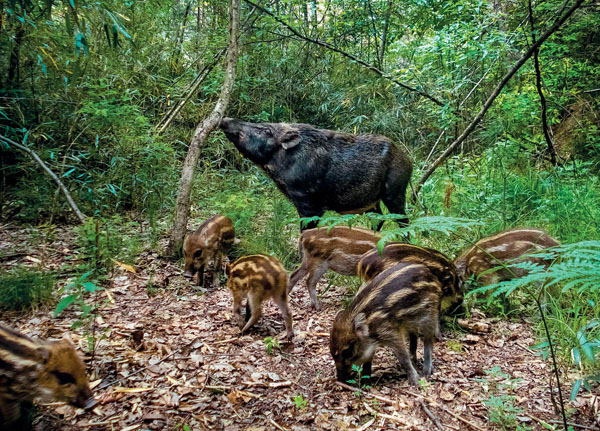Sus scrofa
IUCN
LCBasic Information
Scientific classification
- name:Sus scrofa
- Scientific Name:Wild boar, mountain boar, pig fat, Eurasian wild boar
- Outline:Ungulata
- Family:Artiodactyla Suidae Sus
Vital signs
- length:1.5-2m
- Weight:90-200kg
- lifetime:50year
Feature
One of the most widespread species of all terrestrial mammals in the world
Distribution and Habitat
It is widely distributed in Eurasia, near-land islands and a corner of northwestern Africa, and has been artificially introduced to all continents except Antarctica. In China, it is widely distributed in the vast areas of Northeast China, North China, Central China, East China, South China and Southwest China (usually below 3500m above sea level), except the Qinghai-Tibet Plateau, Mongolian Plateau and Northwest Desert.
It has strong adaptability and can live in various types of habitats, including forests, shrubs, plantations, grasslands, and habitats at the junction of forests and farmlands.
Appearance
A stocky pig, similar in size to a domestic pig but with a longer snout and thick, long hair. The color varies widely, from dark gray to brown to gray-black. Adults have long bristles on their backs and necks. Adult males have significantly elongated, thick, and outward-turned lower canines, forming "fangs." Young pigs have alternating brown and light yellow longitudinal stripes that disappear in their first year as they age.
Details
Wild boars are medium-sized mammals with 20 subspecies. They have a sturdy body, a large head and front end, and a small back. They have short, thick limbs, a long head, small and upright ears, and a protruding cone-like snout with an exposed cartilage pad (also known as an arched nose). Each foot has 4 toes and hard hooves, with only the middle 2 toes touching the ground. Their tails are thin and short. Because of their very small eyes, wild boars have very poor eyesight, but they have a long, straight nose, which gives them an incredibly keen sense of smell.
Male wild boars have two pairs of constantly growing canine teeth that are exposed and turned upwards in a tusk-like shape. They can be used as weapons or digging tools. The canine teeth are an average of 6 cm long, of which 3 cm are exposed outside the mouth. The canine teeth of female Eurasian wild boars are shorter and do not protrude outside the mouth, but they also have a certain degree of lethality.

Wild boars are omnivorous and can eat almost all edible food they encounter, including plant roots, branches and leaves, berries, nuts, crops, invertebrates, small vertebrates, etc. They are important plant seed spreaders. They also eat animal carcasses (scavengers).
Wild boars usually live in groups, but the social structure is loose, and solitary individuals, mother-child groups or mixed groups can often be seen. Wild boars have strong reproductive capacity, and the litter size is usually more than 5-10, and adult females can produce 2 litters per year. In its distribution area, it is an important prey species for large carnivores (such as tigers, leopards and jackals).
Wild boars are the wild ancestors of most (but not all) domestic pig strains. They can hybridize with domestic pigs, and artificially bred hybrid offspring can be seen in some mountainous areas. In areas where agriculture and forests meet, they frequently feed in farmland or plantations, and are one of the main species that cause conflicts between humans and animals.








